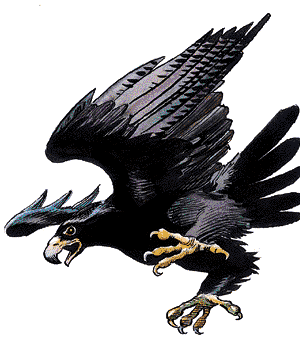

2107

| Ordinary | Huge | Giant | |
|---|---|---|---|
| Climate/Terrain: | Any/Land | Any/Land | Any/Land |
| Frequency: | Common | Rare | Rare |
| Organization: | Flock | Flock | Flock |
| Activity Cycle: | Day | Day | Day |
| Diet: | Omnivore | Omnivore | Omnivore |
| Intelligence: | Animal (1) | Semi (2-4) | Low (5-7) |
| Treasure: | See below | See below | See below |
| Alignment: | Neutral | Neutral (evil) | Neutral (evil) |
| No. Appearing: | 4-36 | 2-8 | 4-16 |
| Armor Class: | 7 | 6 | 4 |
| Movement: | 1, Fl 36 | 1, Fl 27 | 3, Fl 18 |
| Hit Dice: | 1-2 hp | 1-1 | 3+2 |
| THAC0: | 20 | 20 | 17 |
| No. of Attacks: | 1 | 1 | 1 |
| Damage/Attack: | 1 | 1-2 | 3-6 |
| Special Attacks: | Eye peck | Eye peck | Nil |
| Special Defenses: | Not surprised | Not surprised | Not surprised |
| Magic Resistance: | Nil | Nil | Nil |
| Size: | S (2-4’ span) | M (4-6’ span) | L (6-10’ span) |
| Morale: | Average (8-10) | Steady (11-12) | Elite (13-14) |
| XP Value: | 15 | 35 | 175 |
Ravens and crows are large, black birds known primarily as one of nature's primary scavengers. They are often mistaken as bad omens by superstitious farmers and peasants. In fact, popular mythology supports these views, as many religions speak often of the “evil black” raven and the “trickster” crow.
Ravens and crows have their own limited language. Certain ravens, including some huge and most giant specimens, can speak as many as 100 words of the common tongue and can communicate in meaningful phrases (depending on intelligence, of course). For this and other reasons (like their usefulness as garbage disposals, guardians, and vermin hunters), most ravens and crows make very fine house and yard pets.
Combat: Because of the use of scouts within the flock of birds (see below), ravens and crows cannot be surprised during daylight conditions. Ravens and crows attack with both their strong daws and their long, sharp beaks. However, the claws are used mostly for balance and often to obscure the sight of the victim, so only the beak causes actual physical damage. Therefore, ravens and crows employ a grab and peck approach to combat.
Because of their intelligence, these birds are 10% likely to attack an opponent’s eye. In other words, whenever an attack roll indicates a hit, there is a 1 in 10 chance of an eye attack and a resulting loss of that organ.
Ravens and crows are not adverse to teaming up against a single foe, and the chance of blinding a potential victim increases dramatically as the number of birds attacking increases. Fortunately, the rules for multiple attackers in the Dungeon Master’s Guide apply to these creatures as well.
Habitat/Society: Ravens and crows are found from cold-temperate to tropical climes. All birds of this type travel in flocks. Any that are encountered alone are actually scouts. As soon as any approaching creature that could threaten the flock is seen or detected, the scouts give warning cries, screen themselvs, and maintain a safe distance while keeping track of the creatures and reporting events to the flock by means of raucous calls. In any case, all ravens and crows are fiercely loyal to the few friends they make in a lifetime.
Ecology: Ravens and crows are principally scavengers, but, being omnivorous, they also raid crops, nests, or unattended caches of food. Tales of giant ravens spiriting off babes from their cribs are more iiely frightening myths than proven fact, but this feat is possible nonetheless.
All birds of this sort love objects that glitter and shine. Thus they are 25% likely to have several small metal objects, gems, and the like in their nests. In general, the larger the raven (or crow) and the greater the size of the flock, the more valuable and wondrous the small treasures found within.
In fact, some of these birds have been trained to recover such objects with startling results. More than a few simple bird trainers have acquired enough minor magical rings and precious stones to retire in wealth and comfort. Naturally, the specific training methods employed are closely guarded secrets.
Huge Ravens
Huge ravens tend toward malicious dispositions and are known to serve evil masters when opportunity permits. However, not all raven familiars and consorts are evil, as the alignment of the master is a decisive factor in such arrangements.
Giant Ravens
Giant ravens are both pugnacious and easily raised (if trained from fledglings), and so are often used as guards and messengers. While they are decidedly too small to be used as mounts by all but the smallest of humanoids (i.e., faerie folk and characters under the effects of a potion of diminution), the strength of these powerful birds is enough to carry even an adult halfling on an aerial journey. Fortunately, these journeys are rarely more than dangerous pranks, as giant crows, like their smaller brethren, are not fond of dining on meals that are still wiggling. However, more than a few halflings and gnomes have found themselves high atop a barn or mountain ledge with no safe means of descent (much to the amusement of their comrades).

◆ 1506 ◆